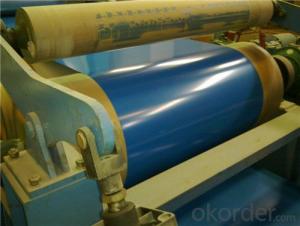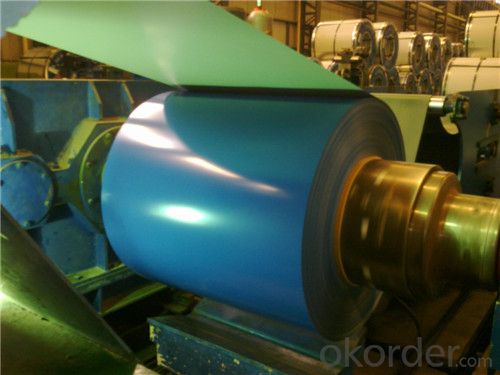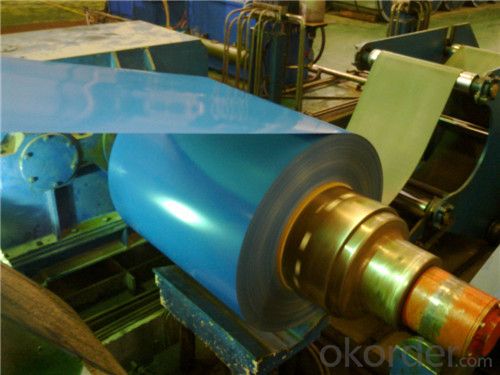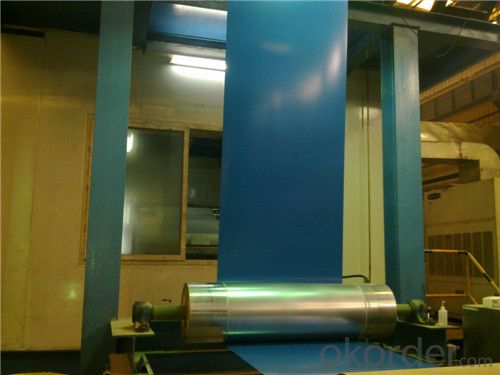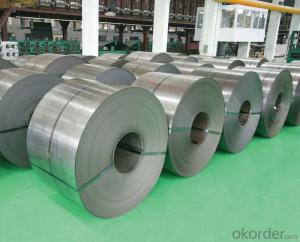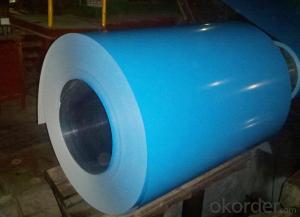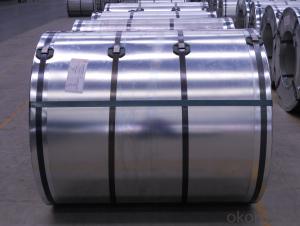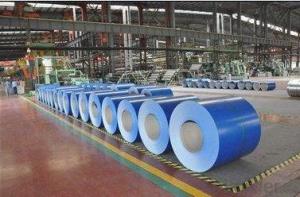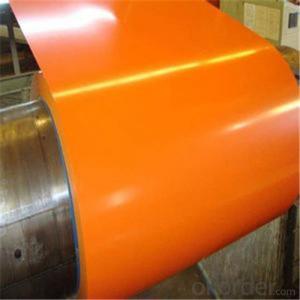color coated galvanized Cold Rolled Steel coil
- Loading Port:
- Tianjin
- Payment Terms:
- TT OR LC
- Min Order Qty:
- 25 m.t.
- Supply Capability:
- 300 m.t./month
OKorder Service Pledge
Quality Product, Order Online Tracking, Timely Delivery
OKorder Financial Service
Credit Rating, Credit Services, Credit Purchasing
You Might Also Like
Product Description
Pre-painted Galvanized Steel Coil
Material: Dx51d+Z, SGCC
Thickness: 0.3-1.2mm
Width: 914mm, 1000mm, 1200mm, 1250mm
Zinc coating: 40g/m2-120g/m2
Primer: About 5 to 7 microns
Top coated: About 8-20 micronS
Back coated: About 5-15 microns (usual: 5-7 micron)
Color: White(RAL9002, 9003, 9016, 9010 ) \blue \red \green\brown and so on
Weight/coil: 3-8tons
ID: 508mm
Packing: Tied by metal wire in bundle, seaworthy, standard package
| Category of Painting | Item | Code | |
| Polyester | PE | ||
| High-durability polyester | HDP | ||
| Silicon modified polyesters | SMP | ||
| Polyvinylidene fluoride | PVDF | ||
| Easy-Cleaning | _ | ||
| Painting Thickness | Top side: 20+5microns; | ||
| Bottom side: 5~7microns. | |||
| Color System | Produce according to RAL Color System or as per buyer's color sample. | ||
| Painting structure | Top surface | Bottom surface | |
| Primer coating | No coating | 1/0 | |
| Primer coating | Primer coating | 1/1 | |
| Primer coating + Finish coating | No coating | 2/0 | |
| Primer coating + Finish coating | Primer coating or single back coating | 2/1 | |
| Primer coating + Finish coating | Primer coating + Finish back coating | 2/2 | |
- Q: im buying a new guitar,, it has a built in tuner and its semi acoustic (can be plugged into an amplifier) ,, im trying to choose which strings are better ,, steel or nylon..?
- That's not an option Guitars are designed for either nylon or steel strings. They aren't interchangeable. Putting steel strings on a guitar designed for nylon strings WILL destroy the guitar. If you've already picked out the guitar you want, then you've already made your decision about nylon or steel.
- Q: What are the common coil loading and unloading procedures?
- Common coil loading procedures involve using cranes or forklifts to lift and position the coil onto a truck or a designated storage area. This process requires careful handling to ensure the coil is properly secured and balanced. Additionally, protective measures such as using steel racks or padding may be employed to prevent damage during transportation. In terms of unloading, the reverse process is followed, with the coil being carefully lifted and placed onto the ground or a designated storage area. Safety precautions are essential during both loading and unloading procedures to minimize the risk of accidents or injuries.
- Q: Why is iron used to create steel? Why not other elements?
- iron came before steel. iron is what was discovered that, under certain circumstances, became a stronger metal: steel. that is why. its like asking why copper is in bronze. because what we call bronze, is an alloy of copper and tin. if you give a more detailed question, i may be able to give a more detailed answer.
- Q: Are steel coils resistant to rust and corrosion?
- Steel coils exhibit resistance to rust and corrosion. Typically, these coils are crafted from either carbon steel or stainless steel, both of which possess exceptional properties for combating corrosion. Carbon steel coils are frequently coated with a protective layer, such as zinc or a polymer coating, to augment their resistance to rust and corrosion. Conversely, stainless steel coils possess inherent corrosion-resistant qualities due to the presence of chromium. This element creates a protective oxide layer on the steel's surface, effectively preventing rust and corrosion. Nonetheless, it is crucial to acknowledge that the extent of resistance may also hinge on the specific grade and quality of the steel employed in the coils, as well as the environmental conditions to which they are exposed.
- Q: How are steel coils used in the manufacturing of electrical wiring?
- Steel coils are not typically used directly in the manufacturing of electrical wiring. However, steel coils can be used in the production of wire drawing machines, which are used to stretch and shape the copper or aluminum wire used in electrical wiring.
- Q: What are the common surface finishes for steel coils?
- The common surface finishes for steel coils include hot-dip galvanized, electro-galvanized, and organic coating finishes such as painted or coated with epoxy or polyester.
- Q: What are the different types of steel coil cutting blades?
- Various types of steel coil cutting blades exist, each specifically designed for particular cutting purposes. 1. Slitting Blades: These blades are utilized to cut steel coils into narrow strips. They possess a straight cutting edge and come in different widths to accommodate various slitting needs. Industries like automotive, construction, and metal fabrication commonly employ these blades. 2. Shearing Blades: These blades are created to cut steel coils into flat sheets. They feature a curved cutting edge that enables a clean and precise cut. Steel service centers, where large coils are transformed into flat sheets for further manufacturing processes, frequently utilize shearing blades. 3. Circular Blades: Also known as rotary blades, these blades are employed for continuous cutting of steel coils. With a circular shape adorned with sharp teeth along the edge, they can effectively cut through the coil as it passes through the cutting machine. Industries such as packaging, printing, and paper manufacturing often make use of circular blades. 4. Guillotine Blades: These blades are employed to cut steel coils in a straight downward motion. Possessing a vertically moving straight cutting edge, they can effectively slice through the coil. Guillotine blades are frequently used in heavy-duty cutting applications that involve thick steel coils or large quantities of material. 5. Slitter Knives: Similar to slitting blades, slitter knives are typically smaller and employed in slitting machines that require multiple blades. Industries requiring high-precision slitting, such as electrical transformer production or precision metal stamping, often rely on slitter knives. Each type of steel coil cutting blade possesses unique characteristics and designs that render them suitable for specific cutting tasks. The appropriate blade selection depends on factors like steel coil thickness and width, desired cut quality, and specific application requirements.
- Q: How are steel coils used in the production of electrical resistors?
- Steel coils are used in the production of electrical resistors as they provide a conductive path for the flow of electric current. The resistance of the coil is determined by its length, thickness, and material properties, allowing it to regulate the flow of electricity in various applications such as heating elements and electronic circuits.
- Q: What are the common coil storage conditions?
- Common coil storage conditions include keeping the coils in a dry and well-ventilated area, away from direct sunlight and moisture. It is also important to store the coils in a clean and organized manner, preferably on pallets or racks, to prevent damage or deformation. Additionally, maintaining a stable temperature and humidity level is crucial to minimize the risk of corrosion or other forms of deterioration.
- Q: I have some steel wool and a charged 9V Battery, when I connect 2 wires to the battery, then touch the wool with the ends of the wires the wool instantly starts burning, but when I connect 2 wires to the piece of steel wool (a new piece not same one of course) and touch the battery with the ends of the wire nothing happens (see image...)
- What's happening in the first case is that the initial contact of the wire to the steel wool is not very good and there is a high resistance as the touch is made and there is probably a slight spark that starts the steel wool burning. Now it is even harder to make good contact and the process continues. In the second case there is initially a good contact to the steel wool and there is no spark when the circuit is completed at the battery. It would be difficult to cause the heating and the spark at a distance unless you had a way to remotely cause the wire to lightly touch the steel wool. A gas lighter which uses a flint to create a spark is good for igniting a gas burner which will continue to burn by itself, but probably wouldn't cause the steel wool to burn without the energy coming from the battery to keep it going. Steel wool WILL continue to burn if it's in a pure oxygen atmosphere. You might try hooking the battery up to the steel wool as in the second case and using a spark lighter to start some burning close to one of the wire connections to see if the extra battery power might keep the burning going.
Send your message to us
color coated galvanized Cold Rolled Steel coil
- Loading Port:
- Tianjin
- Payment Terms:
- TT OR LC
- Min Order Qty:
- 25 m.t.
- Supply Capability:
- 300 m.t./month
OKorder Service Pledge
Quality Product, Order Online Tracking, Timely Delivery
OKorder Financial Service
Credit Rating, Credit Services, Credit Purchasing
Similar products
Hot products
Hot Searches
Related keywords
